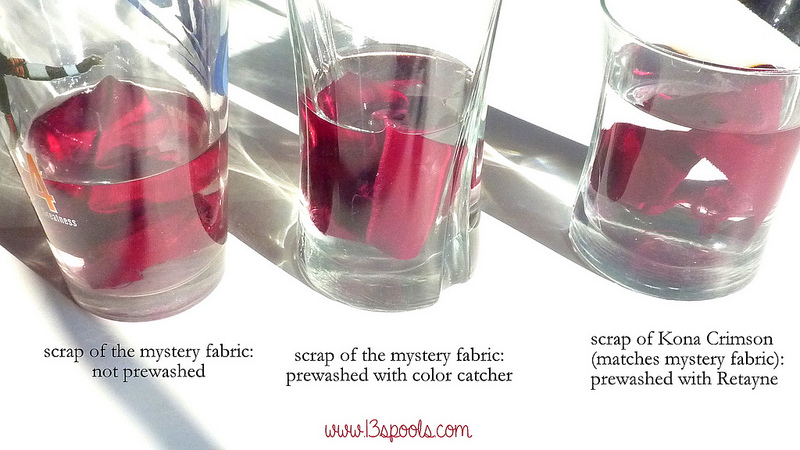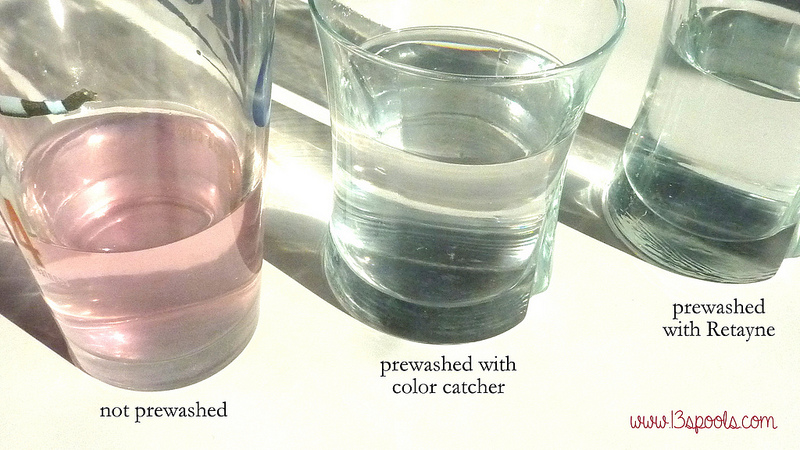More on prewashing...
After my last post on prewashing, I was pretty annoyed about the bleeding I ran into, but still wanted to use the offending red fabric. It looked exactly like Kona Crimson, but I wasn't 100% sure that it was (it may not have been quilt shop quality fabric). I headed out to my LQS, grabbed some Crimson and told them about my issues. One of the workers suggested Retayne (I mentioned this at the end of my last post) and I set forth to pretreat the extra dye out of that fabric! Following the instructions, I washed it on hot with a small amount of the liquid product. It was very easy to use and very cheap - around $3 for the bottle, and it goes quite a ways. But I was curious as to whether or not it really worked, so I decided to do a little experiment.
I grabbed some clear glasses of cool water and put in a scrap of the prewashed mystery fabric as well as a scrap of the prewashed (with Retayne) for-sure-Kona. After an hour, both glasses were still clear when I pulled the scraps out to check. So I grabbed a third glass of cool water and put a scrap of the mystery fabric - UNprewashed - in that one, just to compare.
Then I let them sit for another 2 hours. After 2 hours for the un-prewashed scrap and a total of 3 hours for both prewashed scraps, this is what the glasses looked like:
As I expected, there is some dye in the un-prewashed fabric glass. I actually expecting it to have a lot more dye in it, considering how crazy of a stain it made on my other fabric! I was also pretty surprised to see that the middle glass was just as clear as the glass with the Retayne-treated fabric. Considering the fact that the middle fabric bled in the wash, I wasn't expecting the color catcher to have absorbed all of the excess dye. Interesting.
Some of you made comments about whether or not the color catcher really "worked". Well, I suppose that depends on what you mean by "worked"! As quilters, we generally expect 2 things from color catchers: 1) to absorb the excess dye from fabrics Did the color catcher do this? It would appear so, otherwise there would be at least some dye in this glass. 2) to prevent bleeding - presumably by absorbing the excess dye from fabrics as it enters the water and before it can get locked into surrounding fabrics Did the color catcher do this? No.
I was actually surprised by how faint the color was on the color catcher - it looked even lighter in person than in the photo here. So it didn't seem to absorb a lot of dye, even though the offending fabric lost enough dye to color the neighboring fabric extremely dark!
Now, knottygnome made the following comment: "the problem is that now i have a washer without an agitator and the load doesn't move around as much. i've had some bleeding problems since i got my new washer even with the color catchers. :-(" AH-HAH. That's got to be it. I, too, have a (top-load) washer without an agitator. The problem with this kind of washer is that the fabric doesn't move around and separate, getting tossed around, as it would in a washing machine with an agitator (or probably like a front-load washer). The two pieces of fabric must have gotten smashed against each other (the offending red only bled on two areas onto one other piece of fabric, not onto all of the other fabrics). The problem (most likely) is that the dye wasn't being washed free of the fabric, into the water where the color catcher could collect it. Instead, it just...went directly onto the neighboring fabric.
So did the color catcher work? In as much as the washer gave it the opportunity to. So unfortunately, if there are any fabrics that I want to prewash because I expect them to bleed, I'll have to prewash each piece individually. Sigh.
I'll definitely be using the Retayne for that, because it is much more affordable for such frequent use. Honestly, I'm not a hardcore prewasher and won't become one, even after this. I simply don't have the time/energy to prewash everything separately (if I did, my kids would be in their lovely cloth diapers, not the disposables they are currently wearing!). I will be sticking to the "if it's especially dark or red, try to remember to prewash it" routine with solids. The difference will be that I will be washing the more saturated pieces individually with Retayne (not in a load with like colors).
As a side note, I'm not (personally) worried about dark prints, since the coloring process is very different for those than for solids and I've never had any issues with those.. But if that's your style, then hey, go for it!
Well then. Thanks for joining me for some prewashing experiments, and I hope this helps inform your own prewashing decisions!
After my last post, I thought I would let some scraps of red fabric soak in water to see what would happen to them. I used the same offending fabric, as well as some look-alike Kona Crimson (I'm pretty sure the mystery fabric is Kona Crimson, but I went out and bought some just in cas


